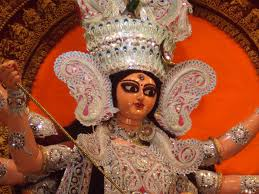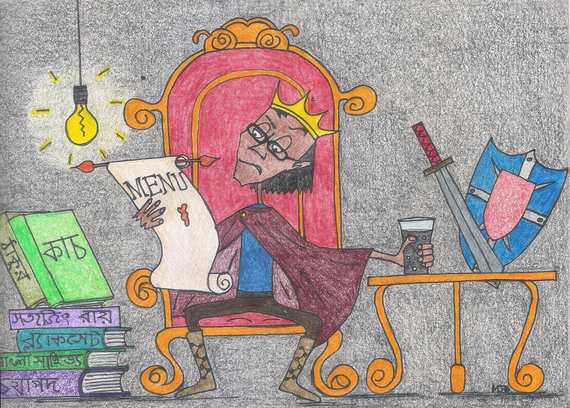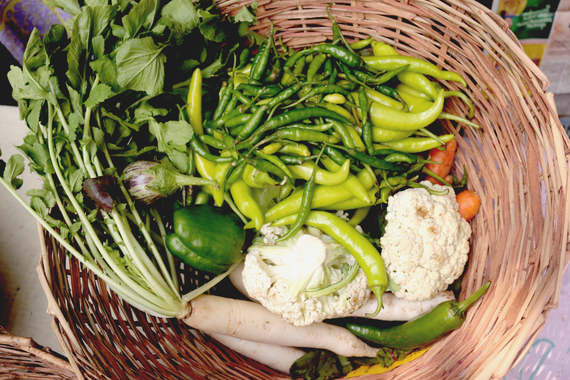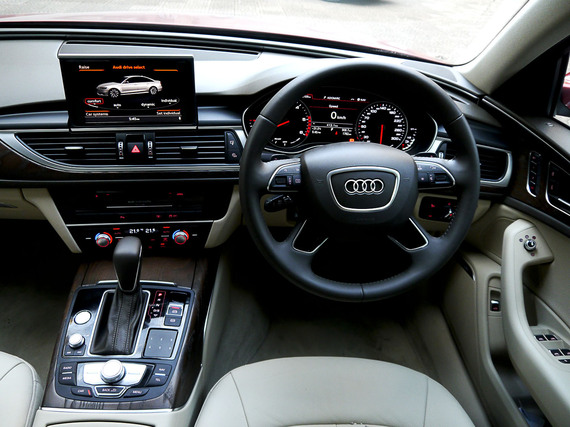(Heart)Breaking News: Most Bengalis, a staggering number of them from West Bengal, haven't ever lived in one of those 'Bengali houses'. You know, the ones with snaking, marble-floored verandahs where deodorants snatch religious Bengali women's abilities to distinguish between a shaved-chested man and a fat piece of hilsa. Or ones with courtyards the size of Zara outlets, where you can watch your crush flirt with your aunt as your heart turns into makha (mashed) sandesh. Or ones in which, men without a single ounce of extra fat on their bodies, dance with a earthen censer held in their mouth. Ones with tall green windows, red floors, weathered ochre pillars. Ones where Pujo means women in red-and-white sarees and elaborate gold naths sitting in haphazard circles arranging flowers in copper vessels and blowing conch shells without their lipstick bleeding into their teeth.
It may be slightly hard to believe that's not your average Kolkata Durga Puja, thanks to a zillion ads, a hundred Bollywood scenes and couture photoshoots which make the festival only and exclusively about the celebrations in old, affluent Bengali families of Kolkata. For a sweeping majority of Kolkata's population, Pujo isn't a Sanjay Leela Bhansali extravaganza unfolding under glittering chandeliers and giant courtyards.
For example, many of us grew up in the matchbox apartments and modest houses that swamp Kolkata and are only worth our individual, perhaps inconsequential, memories. Houses that jostle for space with their clones in lanes and bylanes, apartments landscaped identically, floor after floor, and at times, building after building. Little and big boxes that don't - and maybe cannot afford to - wear the popular 'Kolkata distinguishers' on their skins. What did we build our Pujo around? Apparently, nothing that makes for great cinematic adventures.
And nothing that could appeal to filmmakers and ad filmmakers as convincingly Bengali, it seems. Pandals with frazzled, sweaty, deeply competitive and weary humans. They fight for space, mumble their prayers, click pictures loudly debate the number of coins that should make way into the pronaami (donation) box in a two-minute time span - you don't see much of them in this oh-Bengalis-so-quaint ads.
![durga puja kolkata]()
The little mobs of people in front of the road-side 'Chinese stall' wolfing down orange-red noodles with plumes of diced raw onions and cucumbers sitting on top of each plate, they too hardly ever make the filmi cut.
The crowd - faces shiny with sweat, handkerchiefs and paper horns clutched in the same fist, furiously taking swigs off cola bottles and cursing the traffic as they stand behind ropes held up by irritated traffic sergeants - they are most definitely never going to make it to a commercial or short film trying to scream textbook nostalgia in every frame.
Perhaps that's why, Debi, a promotional short film by Emami Healthy and Tasty, seems to have gone viral on Facebook and has yet left me slightly cold.
The film shows a young girl, born and brought up in America coming to Kolkata for Pujo and meeting her Bengali relatives for the first time. Cooking helps her bind relationships, heal wounded ones and all this happens with Durga Pujo in the backdrop.
![durga puja crowd]()
And like most other preceding ad film and film Pujo, this one doesn't remotely look like mine.
You know what Pujos like mine look like?
Firstly, you may want to heap three pillows on your head in the morning as the neighbourhood pandal starts playing puja chants on the loudspeaker. The chants are most likely to drown under the crackle and groan of the cheap speaker, which would magically work without hiccups later in the day as Kumar Sanu and Sonu Nigam take over. There will be the enthusiastic 'Pujo secretary' uncle - one you can spot by how frequently he is on the phone and the expanding circumference of the damp patch on the stomach of his kurta.
Then the men and women - who mostly keep to themselves the rest of the year - loiter into the pandal. And once they do, they will enquire about the inconsistency of your body weight over the years, nod their heads sympathetically at your insane work hours, your mother's arthritis, the city's traffic and the plummeting quality of fish in the market. There is nothing that goes uncared for inside that little cloth and bamboo structure. There is nothing too personal, nothing that can't be sympathised with, no problem whose solution can't be crowdsourced right there and no misfortune that someone else there hasn't suffered too.
![durga puja crowd]()
Before you and they slink back behind the fences, you are asked to drink a lot of water, not lose any more weight, not drive at night. And if you are single or living alone, you get the supplementary advice on locking doors and shutting windows, and bargaining with domestic helps.
And this is just one of the many, many Pujos which make the big, noisy, feverish Kolkata Pujo.
The tiny pandals colonised by big speakers blaring Hindi music and little boys wriggling to it in the bylanes, the wan, dimly-lit ones with elders sitting and enjoying quiet chats, the Pujos inside apartments, the Pujos eating into the breadth of a main road - the city, this time of the year, is like a colony of doll houses with open doors.
Yet, time and again, popular depictions of it will only crawl over the vast courtyards of a handful of Kolkata homes and blissfully ignore the modern Pujo. It's called 'sarbojonin (meant for all)' for a reason. It's slightly disappointing that the Pujo stories that our filmmakers and ad filmmakers want to say, don't always get its spirit.
It may be slightly hard to believe that's not your average Kolkata Durga Puja, thanks to a zillion ads, a hundred Bollywood scenes and couture photoshoots which make the festival only and exclusively about the celebrations in old, affluent Bengali families of Kolkata. For a sweeping majority of Kolkata's population, Pujo isn't a Sanjay Leela Bhansali extravaganza unfolding under glittering chandeliers and giant courtyards.
For example, many of us grew up in the matchbox apartments and modest houses that swamp Kolkata and are only worth our individual, perhaps inconsequential, memories. Houses that jostle for space with their clones in lanes and bylanes, apartments landscaped identically, floor after floor, and at times, building after building. Little and big boxes that don't - and maybe cannot afford to - wear the popular 'Kolkata distinguishers' on their skins. What did we build our Pujo around? Apparently, nothing that makes for great cinematic adventures.
And nothing that could appeal to filmmakers and ad filmmakers as convincingly Bengali, it seems. Pandals with frazzled, sweaty, deeply competitive and weary humans. They fight for space, mumble their prayers, click pictures loudly debate the number of coins that should make way into the pronaami (donation) box in a two-minute time span - you don't see much of them in this oh-Bengalis-so-quaint ads.
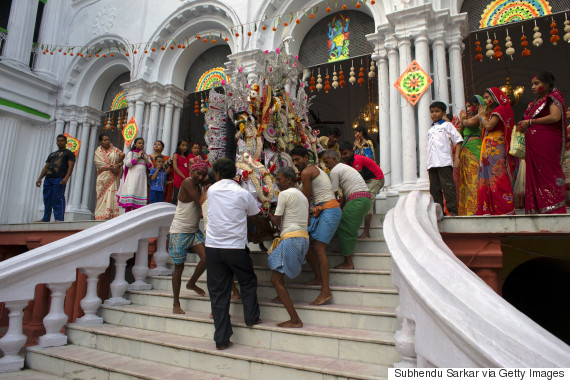
The little mobs of people in front of the road-side 'Chinese stall' wolfing down orange-red noodles with plumes of diced raw onions and cucumbers sitting on top of each plate, they too hardly ever make the filmi cut.
The crowd - faces shiny with sweat, handkerchiefs and paper horns clutched in the same fist, furiously taking swigs off cola bottles and cursing the traffic as they stand behind ropes held up by irritated traffic sergeants - they are most definitely never going to make it to a commercial or short film trying to scream textbook nostalgia in every frame.
Perhaps that's why, Debi, a promotional short film by Emami Healthy and Tasty, seems to have gone viral on Facebook and has yet left me slightly cold.
The film shows a young girl, born and brought up in America coming to Kolkata for Pujo and meeting her Bengali relatives for the first time. Cooking helps her bind relationships, heal wounded ones and all this happens with Durga Pujo in the backdrop.

And like most other preceding ad film and film Pujo, this one doesn't remotely look like mine.
You know what Pujos like mine look like?
Firstly, you may want to heap three pillows on your head in the morning as the neighbourhood pandal starts playing puja chants on the loudspeaker. The chants are most likely to drown under the crackle and groan of the cheap speaker, which would magically work without hiccups later in the day as Kumar Sanu and Sonu Nigam take over. There will be the enthusiastic 'Pujo secretary' uncle - one you can spot by how frequently he is on the phone and the expanding circumference of the damp patch on the stomach of his kurta.
Then the men and women - who mostly keep to themselves the rest of the year - loiter into the pandal. And once they do, they will enquire about the inconsistency of your body weight over the years, nod their heads sympathetically at your insane work hours, your mother's arthritis, the city's traffic and the plummeting quality of fish in the market. There is nothing that goes uncared for inside that little cloth and bamboo structure. There is nothing too personal, nothing that can't be sympathised with, no problem whose solution can't be crowdsourced right there and no misfortune that someone else there hasn't suffered too.
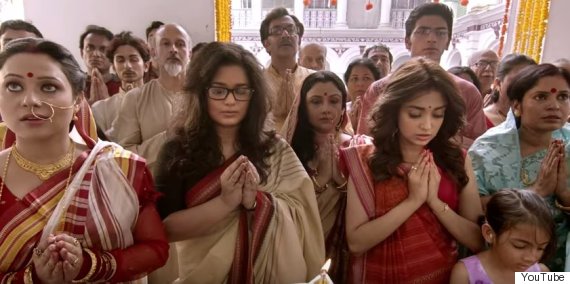
Before you and they slink back behind the fences, you are asked to drink a lot of water, not lose any more weight, not drive at night. And if you are single or living alone, you get the supplementary advice on locking doors and shutting windows, and bargaining with domestic helps.
And this is just one of the many, many Pujos which make the big, noisy, feverish Kolkata Pujo.
The tiny pandals colonised by big speakers blaring Hindi music and little boys wriggling to it in the bylanes, the wan, dimly-lit ones with elders sitting and enjoying quiet chats, the Pujos inside apartments, the Pujos eating into the breadth of a main road - the city, this time of the year, is like a colony of doll houses with open doors.
Yet, time and again, popular depictions of it will only crawl over the vast courtyards of a handful of Kolkata homes and blissfully ignore the modern Pujo. It's called 'sarbojonin (meant for all)' for a reason. It's slightly disappointing that the Pujo stories that our filmmakers and ad filmmakers want to say, don't always get its spirit.





